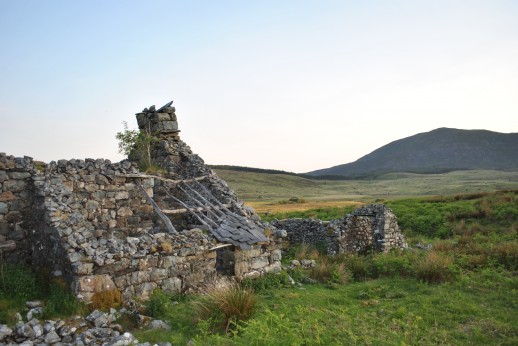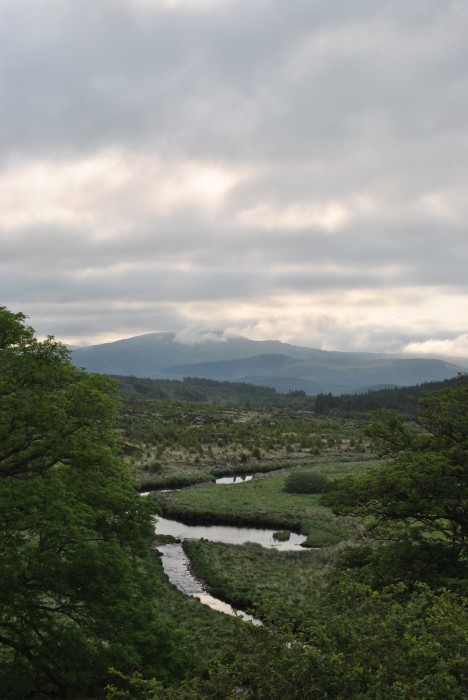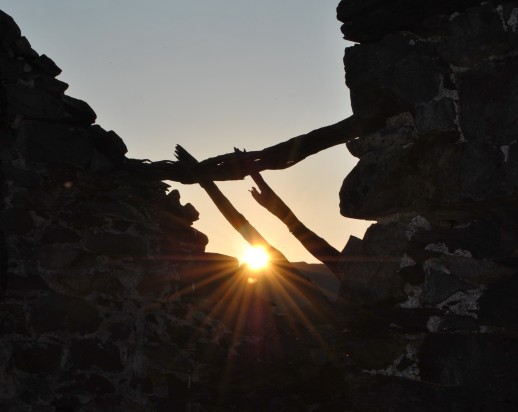A night in an abandoned hamlet by Will Roberts
High in Southern Snowdonia lies a forgotten plateau. It’s a beautiful, wild place. It rains hard and often. The wind bends trees. There are footpaths shown on the map but in reality they are lost, covered in heather or swallowed by bog.
Throughout the nineteenth and early years of the twentieth century people lived and work here; in the slate mine and in a nearby hamlet comprised of three small farms.
In the first few years of the 1900s Gwen Jones was born in this hamlet, one of ten children. Her family rented their cottage because they could not afford to live anywhere better. They farmed sheep as best they could in such marginal land.
It was tough living so remotely, her great-nephew tells me she attended school in a village half a day’s walk away, walking in on Monday, staying with relations during the week before returning on Friday evening.
By the end of the first world war her family and the others had left – pushed by hardships of a life little changed for over two centuries, pulled by the modern world in the valleys below, with its electricity and light and drains and warmth.
Then come the Second World War, man on the moon, civil rights, mobile phones and the internet.
And now I am stood in the doorway of what remains of her home watching the sun setting behind the ridge of hills to the west, an orange glow pouring through the space between two of the peaks. A little of this glow illuminates the few slates still resting on the remaining roof beams.
Walking through the shell of her childhood; I pat the walls, they are solid, half a metre thick maybe and I notice the size of the fireplace – almost two metres wide. It’s easy to picture the family sheltering within – safe from the cold winter nights, the storms and snow.
Suddenly a noise behind me, I turn to see a fox bounding past the back window. I go outside but it has disappeared.
Through foxgloves and bluebells to the river that flows past the houses. There would have been connecting paths once, smoothed by years of children’s feet and grown up shoes but now there are just sheep tracks.
One track leads to another house, marked “glan-llyn-y-forwyn,” on the map – the “bank of the maiden’s pool.” The pool lies in the river below, looking dark and cool. The air is still warm and i’m dirty and hot from hiking across moorland. So I walk to it, take my clothes off and swim. I’m soon out of my depth, treading the peaty water, gasping from the cold water.
Above me fly a few swallows, feasting on the midges rising from the surrounding marsh.
When this pool was last swum in? So long ago. No splashing now, no laughter, just the sound of my breathing and the water burbling over the rocks at its entrance.
After drying myself, I set up camp near the house on the bank.
I try to imagine the final night spent by the family in this place, in their home. There must have been one. After the arguments, after the tearful decision to leave was reached, after the children informed, after the arrangements made. The possessions would have been packed, the cart set to arrive the next morning. Then one final meal perhaps.
A century later I follow the course of this last night. I too make a fire. I too collect water from the river. I too prepare a meal. I think of my actions as a memorial to the people who lived here.
It must have been hard to leave. This place was not simply a location at which to live but their life. These stone shells, these ruins, speak of hard, modest lives lived as part of the landscape. The houses were made from it – rock, wood and slate refashioned to make a home. Their fuel and water were collected from it. And the sheep fed on it.
I drink a brandy toast, wishing them good luck through time. I hope things were better wherever they went.
It’s a week after the solstice and it gets dark slowly and late, but eventually the first stars to appear above the hills.
There are no lights in view, I feel alone. But i’m not – bats appear from the woods and begin circling around me. The people left but they stayed. Perhaps they moved into the deserted houses, the new tenants.
Before I get into my tent I look at the house “on the bank of the maiden pool” again, at the damage.
For years the seasons turned. The roof, weakened by harsh winter after harsh winter eventually caved in. One year the the chimney must have collapsed. Little by little the stones of the walls became covered in vegetation. The place fell back into the arms of nature, embraced by fern, moss and grass.
As a hamlet, the place is dead, just a shadow of human hopes and effort. But life goes on here.
The sun still rises where the river falls – down the valley. In the day swallows, warblers, pippits and larks fly amongst the sheep barns. Ring ouzels pass by on their way to the rockier slopes. Wildflowers bloom and attract bees.
The sun still sets over the hills. At night the barn owls and pipistrelles take flight. In the marsh, frogs call. Around the old buildings foxes prowl.
Yes, life will go on even when the place is erased from human history completely. When the beams have all rotted and the walls have collapsed into the undergrowth, hidden from view. When the memory of those that lived here has been lost, when the place might never have existed, even then it will still be “living”.
Next day I’m woken shortly after 5 by the dawn chorus. I sleep a little more before getting up and strolling around in the morning light.
My fire has gone out so I make tea on my stove. I drink it and watch the clouds gather on the hills, the weather has changed, it’s time to leave.
Just as Gwen’s family did all those years ago, I pack and walk away.
The grid reference for the Snowdonian hamlet is SH69 25 on Ordinance Survey OL18.


